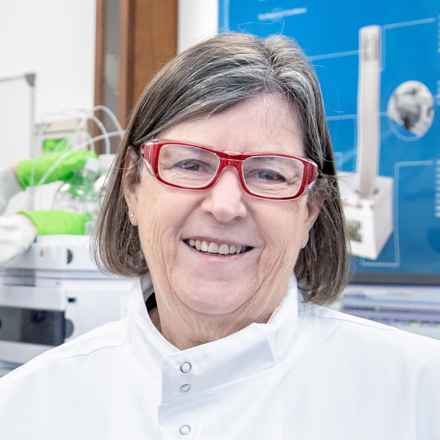Do plants hold the power to cure macular disease?
Posted: Monday 20 June 2022
For hundreds of years, plants have been used in medicine. Primrose to heal wounds, valerian as a sedative, opium poppies for pain relief. Modern medicine wouldn’t be where it is today without the exploration of the medicinal elements of plants and their healing qualities.
Professor Dulcie Mulholland is studying the family of the hyacinth to find a new treatment for macular disease. Her passion for finding the healing power of plants started in her 20s when she had a professor who shared a similar interest in the subject.
So, why does she think plants hold the answers we are all looking for?
Dulcie has answered our questions on her research project, which is being funded by donations from Macular Society supporters.
What sparked your interest in this work?
“My interest in this work started when I was still working in South Africa. As a student I had a very good professor, and that’s what he did, he used to go and look at mahogany plant species. I liked working with little molecules and finding a use for them. So I’ve done it since the age of about 20. So when I see a tree, I think, “what can I find in this tree?”
Why should we be looking for answers from plants?
“The big benefit about plants is they produce this massive library of different structures of their compounds, and if you were just a chemist, sitting in a lab, thinking, “What am I going to make next?” you couldn’t come up with this vast array of different possibilities. Plants produce this amazing library of compounds, which we can find a use for.
“It gives us original ideas. It gives us something to work on.”
Tell us more about the hyancinth and why this family has been chosen for this research?
“In South Africa, we were looking at these plants from the hyacinthaceae family. The hyacinths that you get in the garden in the UK are from that family and there are many, many plants related to that. We were looking at them primarily because the Zulu people use them to rub on sprains, leg breaks, and they’re used as anti-inflammatories. So that was our initial interest, and we found some really good anti-inflammatory compounds.
“We are synthesising these compounds, known as homoisoflavonoids, as they have been found to be very active against treating diseased cells. They have excellent potential for treating vision loss caused by abnormal blood vessel growth in conditions such as blindness in premature babies, diabetic retinopathy, and age-related macular degeneration (AMD).
What benefits does synthasising the plant have?
We decided that, because these plants in the wild are becoming quite rare, and quite hard to get hold of, we should synthesise them. I had a student trying to synthesise them, and we found that we could increase the activity remarkably, almost by 1,000 times. We can therefore make them quite cheaply and they’re relatively easy molecules to synthesise. It also means we are not taking them out of the natural environment.
The plants are overharvested for medicinal use. For example, in Durban, there’s a traditional plant market, where they have piles and piles of plant bulbs, and women go and harvest these out in the forests, and in the hills, and bring them in. And it’s an important source of income for them, so conservation is not top priority on their minds.
So what we do with the plants is we use them to get the initial compounds, to give us ideas of what to synthesise, and we can do that with a kilogram of bulbs, which is not very much, that’s a very small collection, so we’re not harming the environment. We’ve worked on plants from as far away as Madagascar which produce these very active compounds.
The compound that has proven to be most active is a compound that the plants haven’t produced. It’s a derivative which we just happened to make and it’s shown to be a thousand times more active. So plants gave us the idea, but we’ve been able to improve on the activity of what we can get from the plants.
What happens next?
My two PhD students are going over to the Glick Eye Institute in Indianpolis, who we have been working with on this project. The next step would be to create a library of homoisoflavonoids and test them for their ability to block blood vessel growth.
We’re hoping that, by the end of the three-year project, we will have compounds ready to go into larger studies to potentially treat wet age-related macular degeneration, with the aim of putting them into clinical trials.
The cost to the NHS would be a fraction of what is paid, at the moment. And also, the current treatments, I believe, have some side effects, and we don’t believe that these compounds of ours would have those side effects.
Why do you want to find a cure for AMD?
I knew very little about AMD before this research. One of my colleagues has it, and he’s always off for his injections, so I had a vague knowledge about it. But I’ve learnt so much about it and the impact it has.
The numbers of people who have AMD are quite astronomical. If we can use our little molecules to help, and especially to produce a treatment as eyedrops, it will be absolutely wonderful. So the motivation is to really get something on to the market to help people with the condition.
Donate now and help fund vital research to find a cure.
